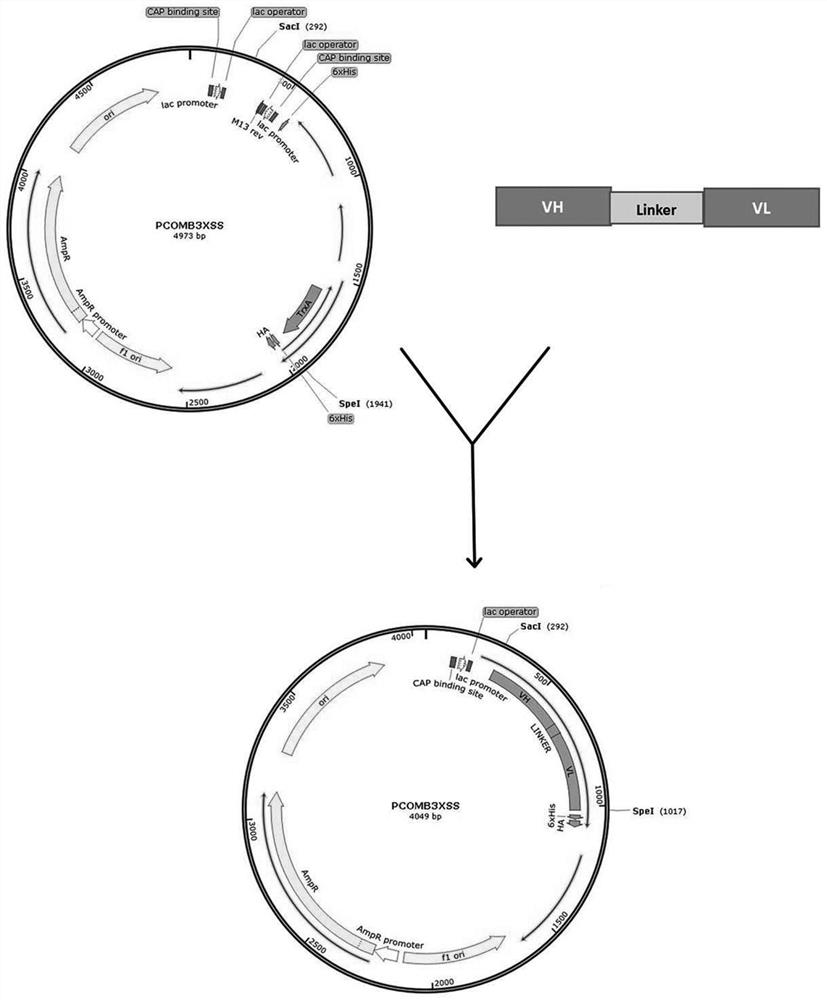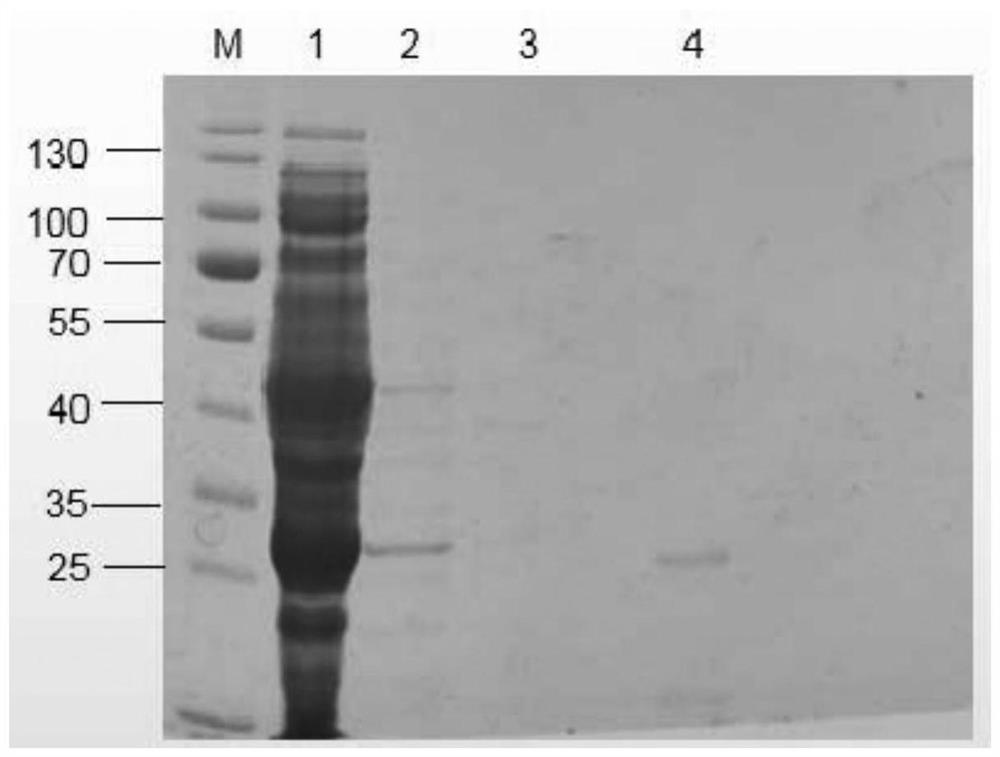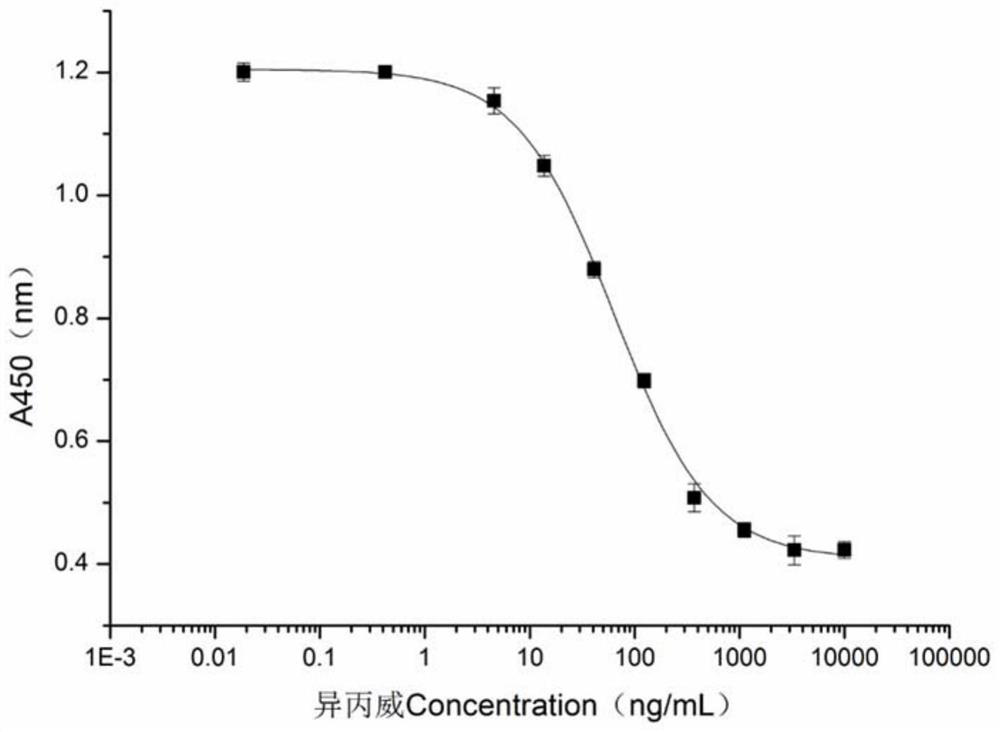A kind of single-chain antibody directly recognizing isoprocarb and its preparation method and application
A single-chain antibody and isoprocarb technology, which is applied in the field of direct recognition of isoprocarb single-chain antibody and its preparation, can solve the problems of expensive instruments and equipment, complicated pretreatment, high detection cost, etc., and achieve good antigen binding activity, good Application prospect, cost reduction effect
- Summary
- Abstract
- Description
- Claims
- Application Information
AI Technical Summary
Problems solved by technology
Method used
Image
Examples
Embodiment 1
[0053] Example 1 Construction Screening and Identification of scFv Recombinant Plasmid
[0054] 1. Experimental method
[0055] In the early stage, our laboratory has successfully synthesized anti-isoprocarb monoclonal antibody. The isoprocarb hapten was coupled with lactoferrin, mice were immunized, and a cell line secreting anti-carbofuran monoclonal antibody was obtained through fusion and cell selection.
[0056] 1. Extraction of total mRNA from hybridoma cells
[0057] S1. Consumables and utensils such as PCR tubes and centrifugal pipette tweezers related to the RNA experiment operation are completely soaked in 0.1% DEPC solution overnight. Pour the DEPC solution as much as possible the next day, and autoclave it for later use;
[0058] S2. Will culture well about 1×10 7 After the hybridoma cells are suspended, add them to a 15mL centrifuge tube, centrifuge at 1000r / min to pellet the cells, discard the supernatant, and use a pipette tip to suck up the residual liquid ...
Embodiment 2
[0116] Example 2 Extraction of soluble expression of scFv antibody
[0117] 1. Experimental method
[0118] The pComb3XSS phagemid carrier used in the present invention is a plasmid carrier containing a phage gene spacer, which combines the advantages of phage and plasmid vectors, and the phagemid has a succinic acid terminator (AmberStop Codon) between the multi-cloning site and gm , when the recombinant phage pComb3XSS-Fab transforms the inhibitory Escherichia coli XLl-Blue, the succinic acid terminator is read through to glutamic acid, and as a result, the antibody fusion protein will be expressed on the surface of the phage, that is, the surface display of the phage. When pComb3XSS-Fab was transformed into non-suppressor E. coli DH5α, the succinic acid terminator was identified as a stop codon, induced by the lactose analogue IPTG, and the antibody was expressed and secreted into the cytoplasm to become a soluble molecule.
[0119] Its expression and extraction steps are ...
Embodiment 3
[0130] Example 3 scFv soluble protein ci-ELISA detection
[0131] 1. Experimental method
[0132] The ci-ELISA detection steps are as follows:
[0133] S1. Coating: Dilute the coating material shown in (I) to a suitable 125ng / mL with the coating solution, add it to the well of the microtiter plate, 100μl / well, and put it in a water bath at 37°C overnight
[0134]
[0135] S2. Washing: Pour off the liquid in the wells, wash the plate twice with a plate washer, add 250 μl of washing solution to each well, and pat dry the liquid in the wells.
[0136] S3. Blocking: add 120 μl of blocking solution to each well, block at 37°C for 3 hours, pat dry the liquid in the well, and place it upside down in an oven at 37°C for 1 hour for later use.
[0137] S4. Adding samples and incubating: Dilute isoprocarb into a series of gradient standard solutions, dilute to 10000, 3333.33, 1111.11, 370.37, 123.46, 41.15, 13.72, 4.57, 1.52, 0.51ng / mL, add 50μl to each well, then Add 50 μl of reas...
PUM
 Login to View More
Login to View More Abstract
Description
Claims
Application Information
 Login to View More
Login to View More - R&D
- Intellectual Property
- Life Sciences
- Materials
- Tech Scout
- Unparalleled Data Quality
- Higher Quality Content
- 60% Fewer Hallucinations
Browse by: Latest US Patents, China's latest patents, Technical Efficacy Thesaurus, Application Domain, Technology Topic, Popular Technical Reports.
© 2025 PatSnap. All rights reserved.Legal|Privacy policy|Modern Slavery Act Transparency Statement|Sitemap|About US| Contact US: help@patsnap.com



